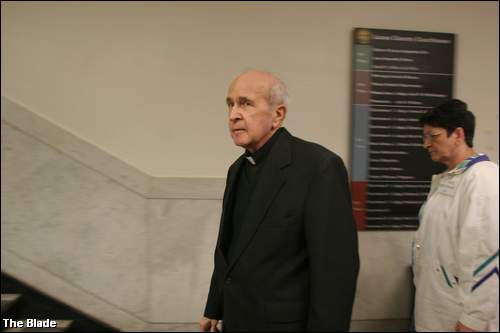By David Yonke
Toledo Blade
July 19, 2006
http://toledoblade.com/apps/pbcs.dll/article?AID=/20060719/NEWS02/607190419/-1/NEWS
A Toledo woman who sued Gerald Robinson in April, 2005, accusing the Roman Catholic priest of torturing and raping her in satanic rituals when she was a child, has filed a motion claiming the statute of limitations did not start ticking until she knew her abuser's identity.
The motion filed Monday in Lucas County Common Pleas Court said the unidentified victim did not know Robinson's name until she saw him on television after his April 23, 2004, arrest for the 1980 ritual killing of Sister Margaret Ann Pahl.
"I recognized him the minute I [saw] him on TV," the plaintiff said yesterday in a telephone interview with The Blade.
 |
| Gerald Robinson |
Robinson, 68, was convicted of murder on May 11 in Common Pleas Court and is serving a 15-years-to-life sentence in the Warren Correctional Facility in southern Ohio. He is believed to be the first U.S. Roman Catholic priest convicted of murdering a Roman Catholic nun.
The plaintiff in the civil suit, who filed anonymously with her husband as Survivor Doe and Spouse Doe, also is suing the Toledo Catholic Diocese, Gerald Mazuchowski, and St. Adalbert's Parish.
The lawsuit states that Survivor Doe recognized Mr. Mazuchowski from a Feb. 20, 2005, article in The Blade in which Mr. Mazuchowski said he was part of an informal group called Sisters of Assumed Mary.
Survivor Doe claims that Robinson, Mr. Mazuchowski, and other "clergy cohorts" dressed as nuns and used women's nicknames during "elaborate, ritualistic ceremonies" in the basement of St. Adalbert's Church on Warsaw Street.
She said the abusers referred to Robinson as "Mary Jerry" and Mr. Mazuchowski as "Carrie Jerry."
Survivor Doe, now in her early 40s, claims the abuse began in 1968 when she was 5 years old and continued until 1975.
In addition to allegations that she was raped and sexually abused, the woman claims Robinson, Mr. Mazuchowski, and other adults wearing nuns' clothing cut her with a knife as a sacrifice to Satan, killed a rabbit and made her drink its blood, and drew an upside down cross on her stomach.
Mr. Mazuchowski and attorneys for Robinson and the diocese have denied the woman's allegations.
Survivor Doe's latest court filing included 42 pages of handwritten rhymes and childlike drawings from journals that she began keeping in 1993, when she said her memories of alleged childhood abuse began to surface.
The journals include crude drawings of men in robes with hats and an upside-down cross. The written phrases include, "I promise I won't tell no one," "They say it's my turn to die, I better shut up that is why," and, "In their mouths were the color red, it was from the blood they said."
Attorneys for the diocese filed a motion in June asking Judge Ruth Ann Franks to dismiss the woman's lawsuit because the statute of limitations had expired.
At the time the civil suit was filed, the statute of limitations was two years after an alleged victim turned 18.
The Ohio legislature has since extended the statute to 12 years after the victim turns 18.
Mark A. Davis, the plaintiffs' attorney, said in Monday's filing that Survivor Doe did not know her abusers at the time, which made it impossible for her to file a suit against the perpetrators.
"This case may be unique in the legal landscape because the defendants actively disguised themselves as nuns and used aliases," the motion said.
Ohio law bars Mr. Davis from commenting on the lawsuit while he is running for a Common Pleas judgeship in November.
Survivor Doe said yesterday that she filed suit because she wants to encourage other victims of abuse to step forward.
"It's not about the money," she said. "If I don't get a dime out of this, I don't care. I just want to help people come forward and heal; to show people how hard it is, but you can do it."
Contact David Yonke at
dyonke@theblade.com or
419-724-6154.
Any original material on these pages is copyright © BishopAccountability.org 2004. Reproduce freely with attribution.